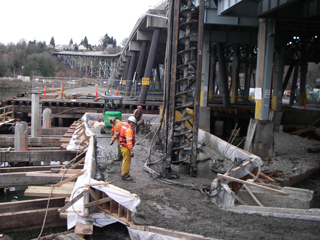
DJC.COM
November 19, 2009
Magnolia Bridge complicates pier project
Hart Crowser

Gutierrez
|
Fishing vessels dock and unload their catch. Cruise ship passengers pass to and from exciting destinations. And commuters crossing the Magnolia Bridge see the commercial hustle and bustle that is routine at Pier 91, located at the south end of Seattle’s Interbay neighborhood. Few are aware of the engineering challenges involved in rebuilding Berth M, just beneath their feet.
Waterfront development projects face unique obstacles under any circumstances. There are sensitive ecologies to protect, political and financial hurdles to clear, and — in Western Washington — shoreline soils that are liquefiable when subjected to vibration, either manmade or caused by an earthquake.
Soil liquefaction can cause buildings and bridges to settle, as we learned from the 2001 Nisqually earthquake. Waterfront pile-driving and construction can also generate significant levels of vibration, which may result in settlement of nearby structures.
With this in mind, imagine being part of a team charged with designing and building a section of pier that extends beneath the 80-year-old Magnolia Bridge — a bridge that supports an arterial to a populous Seattle neighborhood, and that was closed for over three months after the Nisqually earthquake.

Photo by Doug Lindquist/Hart Crowser
Workers drill an augercast pile next to the Magnolia Bridge to support Berth M at Pier 91. Five different types of piles were used for the project. |
This is the situation that the project’s in-house engineering team, led by Sam Asavareungchai of the Port of Seattle, found themselves in when tasked with rebuilding Berth M at Pier 91. Geotechnical engineers Garry Horvitz and Doug Lindquist of Hart Crowser were pressed into service to help solve a number of complex engineering problems.
Berth M history
In 1918, Pier 91 was built on an earthen fill surrounded by a timber bulkhead and timber piles, and topped with a timber apron (the flat surface of the pier that extends out over water). Since the 1990s, the port has been working on a pier-replacement program in sections, replacing the timber bulkhead, piles and apron with steel and concrete.
By 1996, Berth M was closed to traffic; its structure was compromised because of severely deteriorated timber piles and apron decking. It was the last section of Pier 91 to be rebuilt because of its complex location.
| Berth M |
|
Owner: Port of Seattle General contractor: General Construction Co. Civil/structural engineer: Port of Seattle Geotechnical engineer: Hart Crowser Augercast pile contractor: Pile Contractors Micropile contractor: Northwest Cascade |
Of Berth M’s 215-foot apron, 40 feet are located under the Magnolia Bridge. The apron actually surrounds one of the concrete columns that support the bridge.
The Magnolia Bridge, built in 1929, is one of three bridges that connects Seattle’s Magnolia neighborhood to the rest of the city. After it suffered damage from the Nisqually earthquake, the weakest areas were reinforced with steel supports. Plans are under way to replace the Magnolia Bridge; however, the port needed Berth M completed before work on the bridge begins.
Engineering challenges
Preventing damage to the Magnolia Bridge was a primary objective throughout design and construction. Under ordinary circumstances, Berth M would have been rebuilt by driving steel and concrete piles to form a new bulkhead and support the apron. But vibration from driving piles near the bridge could potentially weaken it further. Even if traditional construction methods were an option, pile-driving machinery wouldn’t fit under the bridge.
When asked about the complexity of designing and building Berth M, Asavareungchai said, “This is the only project that I have encountered with this combination of challenges in my 25 years with the Port of Seattle.”
He explained, “We could not drive piles within 50 feet of the Magnolia Bridge, and we only had 15 feet of headroom under the bridge for construction equipment.”
Throughout the process, the Berth M design team worked closely with designers working on plans for a new Magnolia Bridge to make sure that the new pier section would integrate with designs for the future bridge. Creativity, flexibility and communication were crucial to the success of this project.
A primer on piling
Most people have encountered a construction site where pile driving is taking place: thunk, thunk, thunk! Even if the technical anatomy of piles is beyond most people’s understanding — or interest — we know that piles provide foundation and stability to manmade structures. Within the world of subterranean support is a wide variety of piles, offering a range of structural features and construction techniques.
The type of pile most people recognize — driven piles — are made of concrete or steel and are hammered into the ground until they reach a layer of soil or rock that will support the finished structure. Steel piles can be either solid steel or steel pipes. Sheet piles are another type of driven pile, consisting of steel panels that interlock to form a continuous wall. Sheet piles are used for retaining walls, bulkheads and seawalls.
Drilled and cast-in-place piles are widely used but may be unfamiliar to many people. Augercast piles are cast in place using an auger to bore a hole of the appropriate diameter and depth. Then, a grout mixture is pumped through the auger into the hole, under pressure, to form a strong column as the auger is withdrawn. A metal reinforcing cage is lowered into the grout to provide strength.
Micropiles are a smaller type of cast-in-place pile. They are narrower in diameter (less than 12 inches) and are frequently placed in groups to cumulatively provide the strength and support of a large pile. They are drilled and filled with grout around a steel reinforcing bar.
Five-pile solution
Five types of piles were specified to support Berth M. While the piles themselves aren’t unique, the way they were used is. Engineers designed the piling to meet the structural needs of the pier, applying different techniques as construction grew closer to the Magnolia Bridge.
Farthest from the bridge, 24-inch-diameter precast concrete piles were driven into a bearing soil layer with a hydraulic hammer. Around the bulkhead, sheet piles — the wide, interlocking steel piles — were driven to retain the earthen fill. Alongside the bulkhead, angled 24-inch-diameter steel pipe piles were driven to provide vertical and lateral support.
Within 50 feet of the Magnolia Bridge, 24-inch augercast piles were used to support Berth M. Directly under the bridge, micropiles were used for support.
Not only did the augercast and micropiles solve the pile driving vibration problem, the equipment used to build micropiles does not require as much headroom as other pile installation equipment. This allowed the micropile contractors to install piles beneath the bridge.
To ensure that construction did not affect the bridge, a vibration and settlement monitoring system was established. Work within 50 feet of the bridge’s foundation was monitored for vibration, and optical points on the bridge columns were surveyed regularly to ensure that the bridge was not moving.
The result of these creative design and construction solutions is invisible to all the fishers, tourists and commuters who cross Pier 91 every day. And, chances are, they will continue to go about their business, oblivious to the complex project that took place below them.
Mary Gutierrez is technical editor at Hart Crowser, a firm providing geotechnical and environmental engineering, and natural resources and hydrogeology services.
Other Stories:
- Bellingham embarking on ambitious waterfront plan
- Placid park belies a major engineering effort
- 21st-century waterfronts: What makes them work?
- Bellevue reconnecting with its waterfront
- Planning a shoreline project? Win over the public first
- Kennewick island lighthouse a beacon for downtown
Copyright ©2009 Seattle Daily Journal and DJC.COM.
Comments? Questions? Contact us.